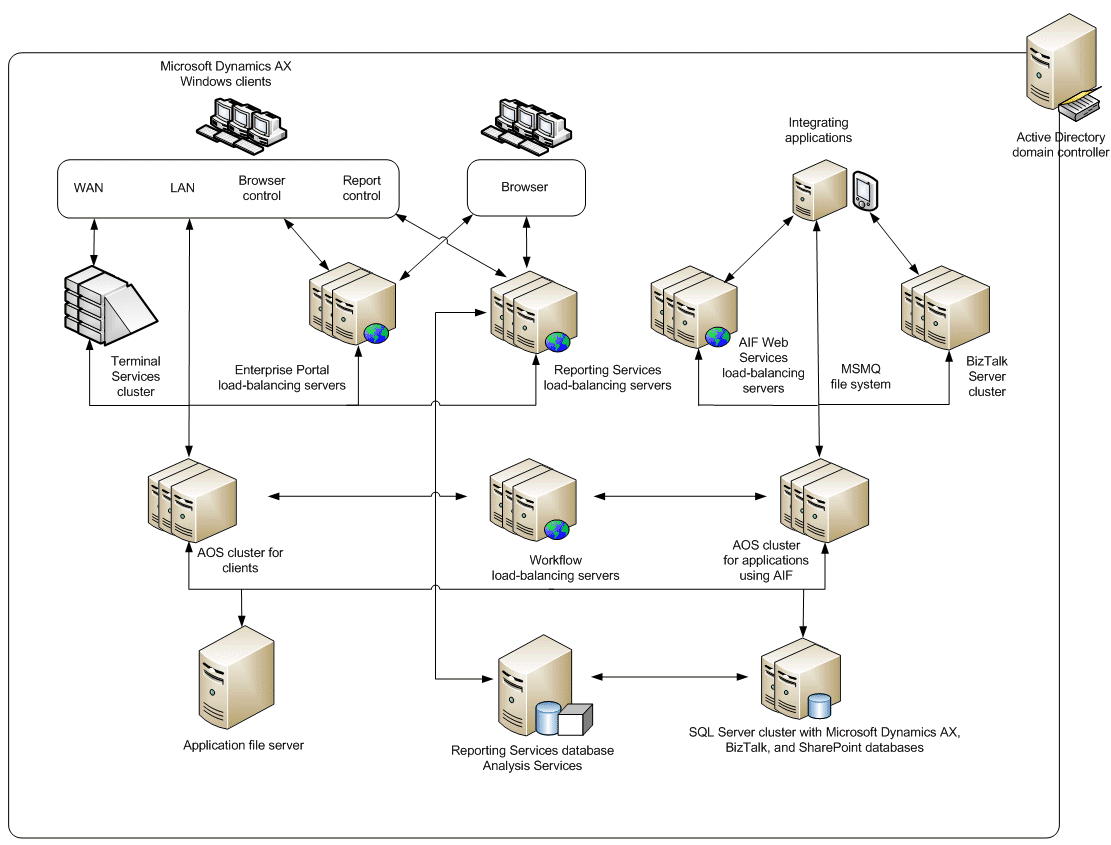This topic provides a sample topology for a large-scale, distributed deployment. This topology expands the large-scale deployment (described in the Large-scale deploymenttopic) by adding Web server clusters and AOS server clusters.
This topology requires Kerberos authentication. For more information about configuring Kerberos authentication in your Microsoft Dynamics AX environment, see the Installation Guide.
The diagram below shows the sample topology for a large-scale, distributed deployment.

The following list describes how the computers in this sample topology are used:
-
An Active Directory domain controller is required for deploying Microsoft Dynamics AX components.
-
Microsoft Dynamics AX Windows clients connecting over a Wide Area Network (WAN) are configured to use Terminal Services to communicate with the AOS. Microsoft Dynamics AX Windows clients on the Local Area Network (LAN) are configured to communicate with the AOS directly.
-
Dedicated, load-balancing servers host each of the following components:
-
Enterprise Portal
-
Reporting Services
-
Application Integration Framework (AIF) Web services
-
Workflow
-
-
A BizTalk server cluster provides application integration through the Microsoft Dynamics AX BizTalk adapter. (File system-based and Microsoft Message Queue (MSMQ)-based application integration directly communicates with the AOS.)
-
Two AOS server clusters are deployed. One AOS server cluster is used for Microsoft Dynamics AX clients. The other AOS server cluster is for application integration using AIF. AIF uses batch servers to process tasks.
 Note
Note
You can configure an active AOS server to act as a batch server. Depending upon the configuration, a batch server can use multiple threads to process batch tasks in parallel. A batch server uses one thread per batch task. If you configure a batch server with ten threads and there are ten batch tasks waiting for processing, the batch server will use all available (ten) threads and start processing the tasks in parallel. Processing of batch tasks uses server resources and may impact Microsoft Dynamics AX users. For more information about batch servers, see Batch server.
-
The application file server is deployed on a single server. For high availability considerations, see Application file server topology.
-
Analysis Services and the Reporting Services database are deployed on a dedicated server.
 Caution
Caution
Reporting Services and Analysis Services are not supported in a failover cluster.
-
A SQL Server cluster hosts the relational databases for the Microsoft Dynamics AX application and server components.
 Note
Note
You need to determine if your SQL Server infrastructure supports the workload generated by the Microsoft Dynamics AX application and its associated components. You may need to distribute some of the components, such as the BizTalk database, to a separate SQL Server computer.






